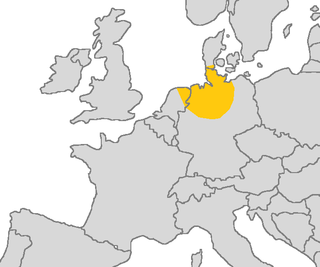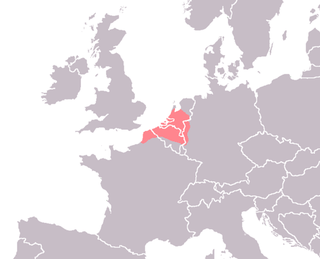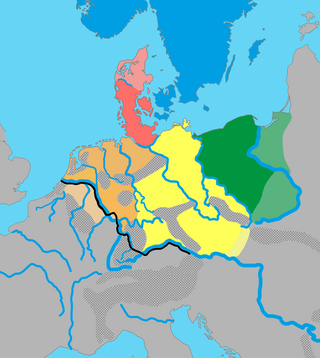Related Research Articles

The Germanic languages are a branch of the Indo-European language family spoken natively by a population of about 515 million people mainly in Europe, North America, Oceania, and Southern Africa. The most widely spoken Germanic language, English, is also the world's most widely spoken language with an estimated 2 billion speakers. All Germanic languages are derived from Proto-Germanic, spoken in Iron Age Scandinavia, Iron Age Northern Germany and along the North Sea and Baltic coasts.

Old Norse, also referred to as Old Nordic, or Old Scandinavian, was a stage of development of North Germanic dialects before their final divergence into separate Nordic languages. Old Norse was spoken by inhabitants of Scandinavia and their overseas settlements and chronologically coincides with the Viking Age, the Christianization of Scandinavia, and the consolidation of Scandinavian kingdoms from about the 8th to the 15th centuries.
The Germanic umlaut is a type of linguistic umlaut in which a back vowel changes to the associated front vowel (fronting) or a front vowel becomes closer to (raising) when the following syllable contains, , or.

The West Germanic languages constitute the largest of the three branches of the Germanic family of languages. The West Germanic branch is classically subdivided into three branches: Ingvaeonic, which includes English, the Low German languages, and the Frisian languages; Istvaeonic, which encompasses Dutch and its close relatives; and Irminonic, which includes German and its close relatives and variants.
In the Germanic languages, weak verbs are by far the largest group of verbs, and are therefore often regarded as the norm. They are distinguished from the Germanic strong verbs by the fact that their past tense form is marked by an inflection containing a, , or sound rather than by changing the verb's root vowel.

Proto-Germanic is the reconstructed proto-language of the Germanic branch of the Indo-European languages.
Old Frisian was a West Germanic language spoken between the 8th and 16th centuries along the North Sea coast, roughly between the mouths of the Rhine and Weser rivers. The Frisian settlers on the coast of South Jutland also spoke Old Frisian, but there are no known medieval texts from this area. The language of the earlier inhabitants of the region between the Zuiderzee and Ems River is attested in only a few personal names and place-names. Old Frisian evolved into Middle Frisian, spoken from the 16th to the 19th century.
North Sea Germanic, also known as Ingvaeonic, is a subgrouping of West Germanic languages that consists of Old Frisian, Old English, and Old Saxon, and their descendants.

Old Saxon, also known as Old Low German, was a Germanic language and the earliest recorded form of Low German. It is a West Germanic language, closely related to the Anglo-Frisian languages. It is documented from the 8th century until the 12th century, when it gradually evolved into Middle Low German. It was spoken throughout modern northwestern Germany, primarily in the coastal regions and in the eastern Netherlands by Saxons, a Germanic tribe that inhabited the region of Saxony. It partially shares Anglo-Frisian's Ingvaeonic nasal spirant law which sets it apart from Low Franconian and Irminonic languages, such as Dutch, Luxembourgish and German.
Proto-Norse was an Indo-European language spoken in Scandinavia that is thought to have evolved as a northern dialect of Proto-Germanic in the first centuries CE. It is the earliest stage of a characteristically North Germanic language, and the language attested in the oldest Scandinavian Elder Futhark inscriptions, spoken from around the 2nd to the 8th centuries CE. It evolved into the dialects of Old Norse at the beginning of the Viking Age around 800 CE, which later themselves evolved into the modern North Germanic languages.
I-mutation is a type of sound change in which a back vowel is fronted or a front vowel is raised if the following syllable contains, or. It is a category of regressive metaphony, or vowel harmony.
In historical linguistics, vowel breaking, vowel fracture, or diphthongization is the sound change of a monophthong into a diphthong or triphthong.
Old English phonology is the pronunciation system of Old English, the Germanic language spoken on Great Britain from around 450 to 1150 and attested in a body of written texts from the 7th–12th centuries. Although its reconstruction is necessarily somewhat speculative, features of Old English pronunciation have been inferred partly from the sounds used in modern varieties of English, partly from the spellings used in Old English literature, partly from analysis of Old English poetry, and partly from comparison with other Germanic languages.
Like many other languages, English has wide variation in pronunciation, both historically and from dialect to dialect. In general, however, the regional dialects of English share a largely similar phonological system. Among other things, most dialects have vowel reduction in unstressed syllables and a complex set of phonological features that distinguish fortis and lenis consonants.

In linguistics, Old Dutch or Old Low Franconian is the set of dialects that evolved from Frankish spoken in the Low Countries during the Early Middle Ages, from around the 6th or 9th to the 12th century. Old Dutch is mostly recorded on fragmentary relics, and words have been reconstructed from Middle Dutch and Old Dutch loanwords in French.
Germanic sound shifts are the phonological developments from the Proto-Indo-European language (PIE) to Proto-Germanic, in Proto-Germanic itself, and in various Germanic subfamilies and languages.

In historical linguistics, the Ingvaeonic nasal spirant law is a description of a phonological development that occurred in the Ingvaeonic dialects of the West Germanic languages. This includes Old English, Old Frisian, and Old Saxon, and to a lesser degree Old Dutch.
The phonology of Old Saxon mirrors that of the other ancient Germanic languages, and also, to a lesser extent, that of modern West Germanic languages such as English, Dutch, Frisian, German, and Low German.
In phonology, fronting is a sound change in which a vowel or consonant becomes fronted, advanced or pronounced further to the front of the vocal tract than some reference point. The opposite situation, in which a sound becomes pronounced further to the back of the vocal tract, is called backing or retraction. Fronting may be triggered by a nearby sound, in which case it is a form of assimilation, or may occur on its own.
The phonological system of the Old English language underwent many changes during the period of its existence. These included a number of vowel shifts, and the palatalisation of velar consonants in many positions.
References
- Campbell, A. (1959). Old English Grammar. Oxford University Press. ISBN 0-19-811943-7.
- Cercignani, Fausto (1980). "Early 'umlaut' phenomena in the Germanic languages", Language 56:1, pp. 126–136.
- Collitz, Hermann (1918), "Early Germanic vocalism", Modern Language Notes 33:6, pp. 321–333.
- Gordon, E. V. (1957). An Introduction to Old Norse. Second Edition revised by A. R. Taylor. Oxford University Press. ISBN 0-19-811184-3.
- Grønvik, Ottar (1983). Die dialektgeographische Stellung des Krimgotischen und die krimgotische cantilena. Oslo, Universitetsforlaget.
- Kock, Axel (1898). "Der a-umlaut und der Wechsel der endvocale a: i(e) in den altnordischen sprachen", Beiträge zur Geschichte der deutschen Sprache und Literatur 23, pp. 484–554.
- Kock, Axel (1890). "Några bidrag till fornnordisk grammatik", Arkiv för nordisk filologi. Ny följd. Andra bandet.
- Kluge (1889). "Vorgeschichte der Altgermanichsen Dialekte", Grundriss der germanischen Philologie, herausgegeben von Herman Paul. Strassburg, Trübner.
- Lloyd L. (1966). "Is there an a-umlaut of i in Germanic?", Language 42:4, pp. 738–745.
- Sturtevant (1956). "The a-umlaut of the radical vowel i in Old Norse monosyllabic stems", Modern Language Notes 71:3, pp. 194–200.
- Wright (1917). Grammar of the Gothic Language. Oxford University Press.